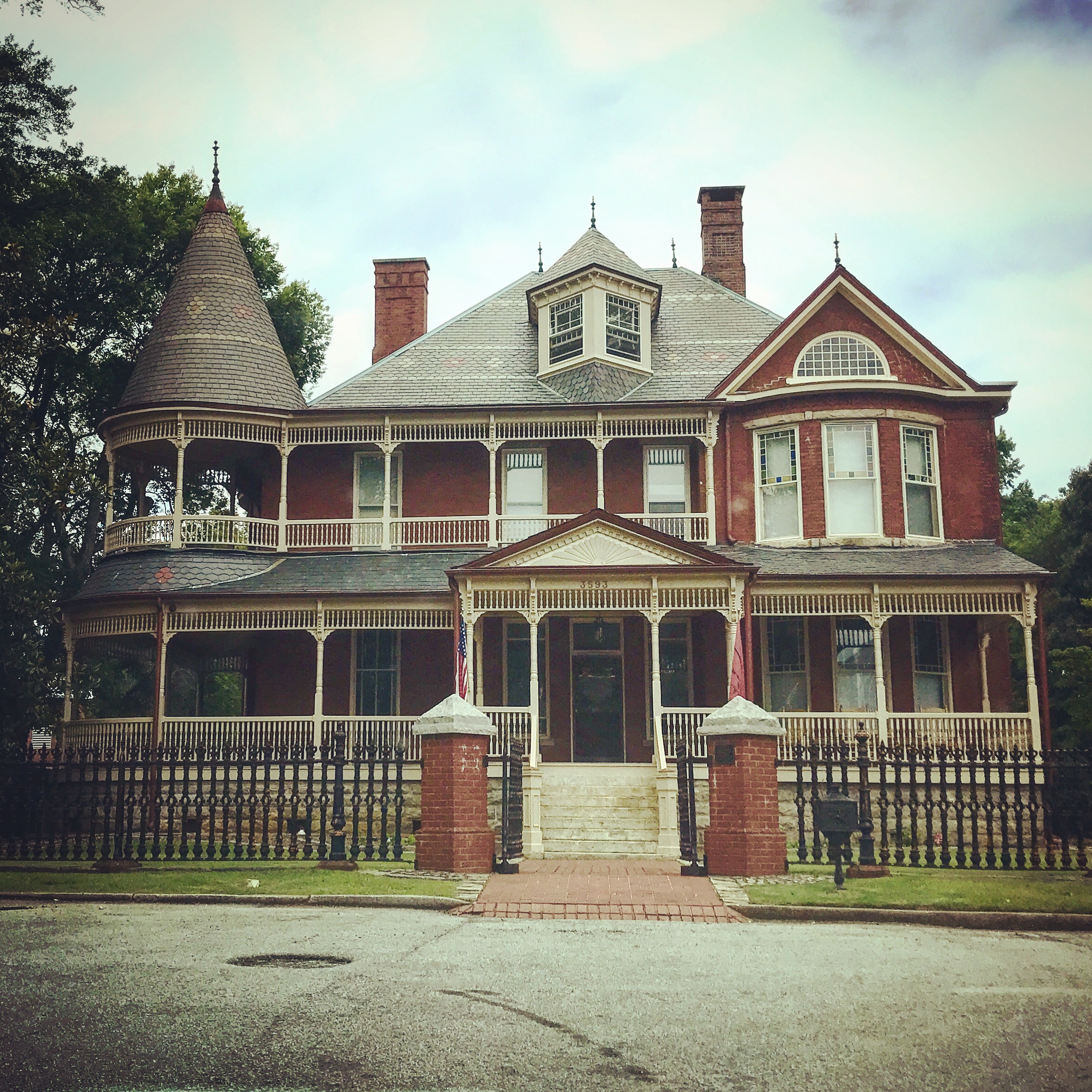
A few days ago I was headed to lunch in College Park but overshot my destination so I hung a right at the very next street, Hemphill, in order to loop the block and make another pass. As I drew near the end of that side street I was confronted by this big beautiful old lady. This morning I did a bit of searching and learned that this is listed on the Historic Register as The Palmour House, but the majority of search results are MLS listings from real estate companies and the top result rendered this interesting tidbit: she was offered at $699,000 but was sold at auction for $599,000 in 2015.
The alumni of College Park High School (the Rams) maintain a website to keep in touch with their fellow classmates and to gather up the history of their hometown. Among the documents on their website was a PDF detailing the history of the Palmour House, and it appears to have been made from a photocopy of a history that may have been prepared by the law firm Stokes & Murphy, which previously occupied the building.
I have taken the time to convert that scanned document back into plain text and am including it below with no claims to authorship (although I did clean up a few errant commas and hyphenate a few words).
“Annabelle”
Grand Lady of College Park
The Palmour House, affectionately known as ‘Annabelle;’ is a gracious reminder of long-ago days when Victorian houses were common in the residential landscape, and our small city was known as a “college town.”
College Park began in 1891 as a planned community known as “Manchester.” Originally designed as an industrial manufacturing town, it began to reflect a more collegiate atmosphere with the presence of Cox College, the second oldest women’s college in the county and Southern Military Academy, which ultimately became Georgia Military Academy and then Woodward Academy. In 1896, Lula Roper won an acre of land with her entry, “College Park ‘ in a contest held to rename the town.
The Palmour House was built for Dr. William Crenshaw, a prominent dentist who founded the Atlanta Dental College (later the Emory Dental School). Dr. Crenshaw married Alice Cox, sister of Cox College’s President, Charles Cox. Her second brother, William, who graduated from Cornell University with a degree in architecture, designed the three-storey Queen Anne style Victorian. “Annabelle” was built close to Cox College, which William Cox also designed.
Construction of the house began circa 1892. Bricks for the structure were molded from red clay-excavated to make way for the massive basement. It is said when Dr. Crenshaw visited the site, he declared the house too small and had the workers dismantle the walls and push the st1ucture out an additional six to eight feet.
Dr. Crenshaw was an avid gardener, as was his daughter, Mary Palmour, for whom the house is named. Mary and her husband Oscar, one of the original three professors to open Southern Military Academy, purchased the house from the Crenshaw estate in 1931. Mrs. Palmour, an expert horticulturist, was beloved by the people of College Park, and many remember her still. She once traveled to South America with Bess Truman on a horticultural tour, and even has a lavender pom pom chrysanthemum named after her called the “Mary Palmour.”
Following Mary Palmour’s death in 1958, the house became in desperate need of repair. The roof leaked so badly that a heavy rain put two inches of water in the upstairs bedrooms. Then, in 1984, she was saved from almost certain demolition by Colonel William Oxford and his wife Tosca, who could not bear to see this glorious home fall into ruin. The Oxfords bought her and, for the next 10 years, lovingly restored her room by room, adding a modern kitchen and sunroom.
The Palmour House contains three storeys over a full basement and encompasses more than 7,500 square feet. The floors are triple-ripped pine, laid at an angle to increase strength. Like many large houses of the day, the kitchen was originally built on to the back of the house, to safeguard the main house against the hazard of fire.
The house was originally lighted by gas light fixtures. Each room has its own unique wall fireplace – 12 in all – and it took a ton of coal a week to heat the house. It was the first home in College Park to enjoy indoor plumbing.
Beautiful woods were used throughout the house, including mahogany, pine and walnut. The hand-carved newel post at the foot of the main stairs reflects the home’s attention to detail and quality. The bamboo-style· trellis in the foyer indicates the period’s focus upon the oriental. Decorative pressed tin ceilings in the drawing room and kitchen, as well as the beautiful lincrusta in the foyer and dining room, are newer additions that enhance the home yet still maintain the integrity of the period.
“Annabelle ” is now home to Stokes & Murphy, a law firm which has tried jury trials in over 30 states. We could not have found a better home base than College Park. Stokes & Murphy serves some of the finest hospitality companies throughout the world, focusing upon labor & employment law in the hospitality and service industries. We purchased the house in 1996 and continue to restore the structure and grounds. Guardians of the home for this generation, we look forward to preserving “Annabelle’s” legacy for generations to come.
– – –
And so there you have the history of Annabelle, as found on the internet. Note that construction of the house began one year after the town’s name was changed from Atlantic City to Manchester, and four years before it would be renamed College Park. I’m sure that it was a fairly heady time for local residents, what with all the renamings and the erection of Victorian homes like Annabelle (though I now wonder if there’s a record of other similar homes being built in the area – was this home unique to the city?).



Thank you so much for this account of one of College Park’s finest homes. My grandparents and mom lived in this beautiful home, renting a room in 1947, and I’ve been fascinated with it ever since.
Thanks again for sharing information about it.